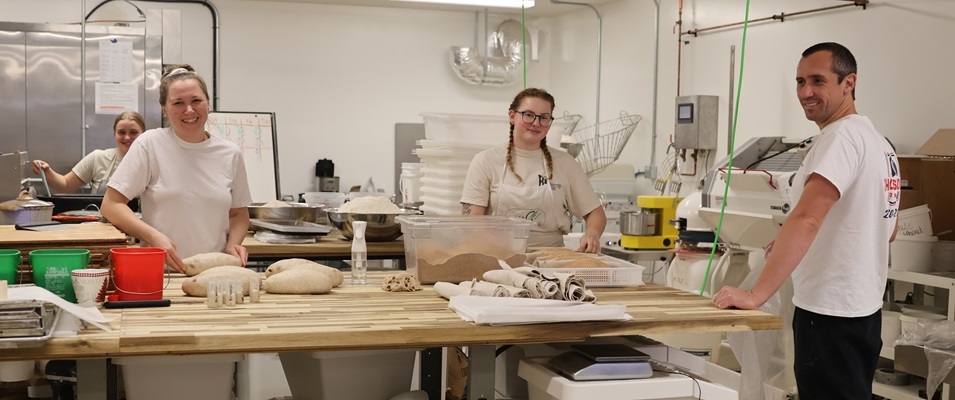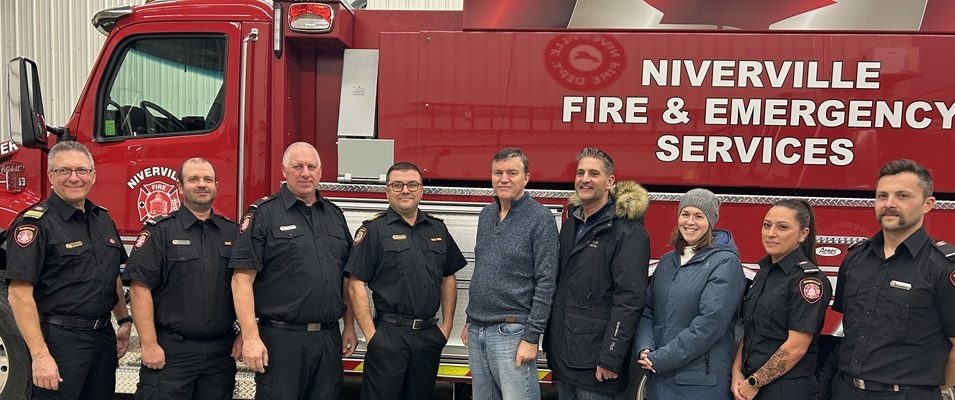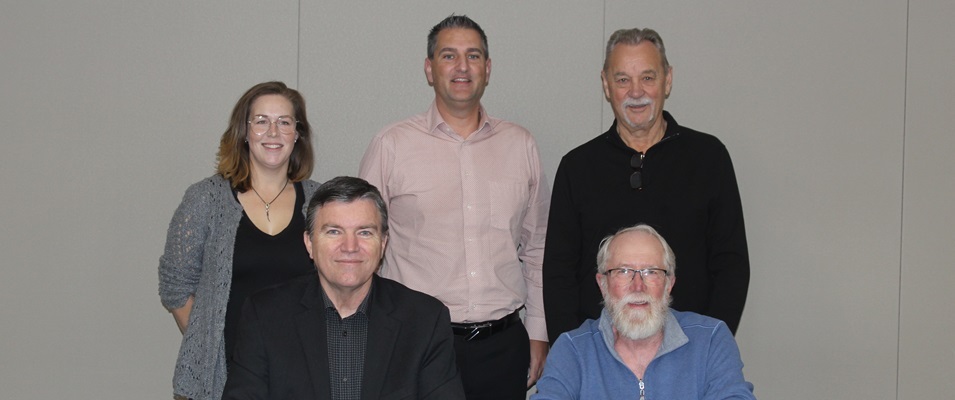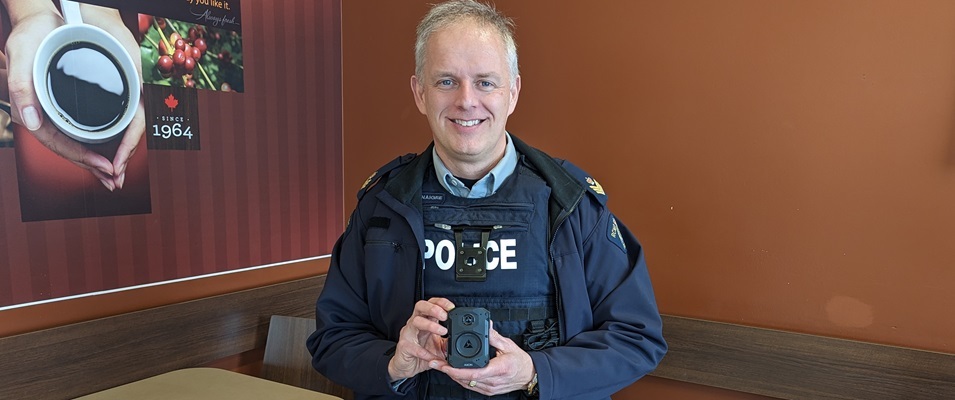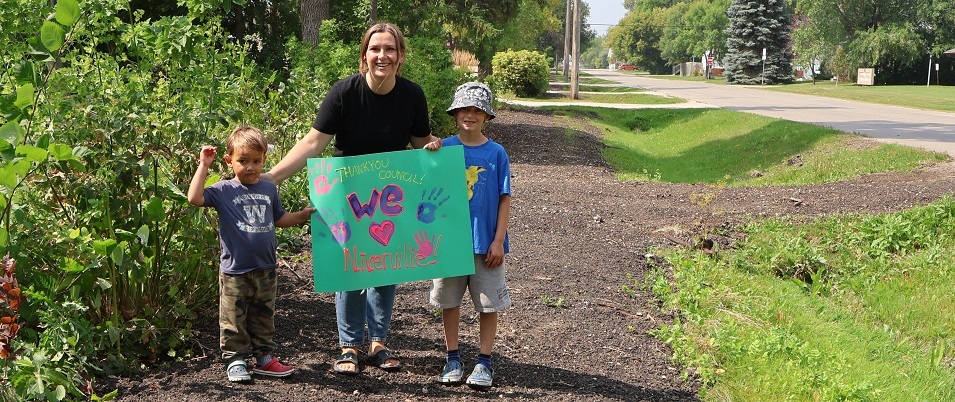
One year ago, residents living along a two-block stretch of Niverville’s First Street South reached out to The Citizen with concern over the state of their street’s sidewalk, portions of which were as good as unusable.
Twelve months later, the entire sidewalk has been removed and there’s no promise of a new one.
Most would say that the town made the right choice in removing the sidewalk based on the state it was in—broken, disjointed, and overgrown in places. In fact, the residents here would agree, citing the unreliability of winter snow-clearing due to the sidewalk’s rough condition.
Still, they had hoped town council would respond to their appeals for a replacement sidewalk, even if it ran for only a few blocks.
Crystal Isaak lives on the corner of Fifth Avenue South and First Street South. When the sidewalk bordering her property was removed and filled in this summer, she reached out to council, appealing for a new sidewalk installation.
“[Our street is] unlike [new] developments,” Isaak told council. “There are no curves or bays or cul-de-sacs. We are used as a straightaway through town and a way to access businesses. Our street supports the function of Main Street in a significant way.”
While Isaak is relatively new to her current residence, she lived in another house along First Street South more than a decade ago and has witnessed firsthand how this once relatively quiet street has morphed into a busy thoroughfare.
The annual fair is just one example of a time when her residential street becomes overwhelmed with foot and vehicular traffic for days on end.
That’s just one weekend per year. The balance of the year, she says, sees a lower volume of traffic, but it’s constant and at times moves way too fast to share the road safely with the prolific number of pedestrians and bikers.
Things have gotten worse, she adds, since the traffic light was installed at the corner of Fifth Avenue and Main. Now a lot of the northbound traffic on Fifth Avenue turns onto her street to avoid having to wait at the red light. Oftentimes they’re in a hurry and making up for lost time along this stretch.
As well, Isaak sees a lot of people using First Street South as a preferred way to access Main Street businesses from the rear, avoiding the need for U-turns on Main Street. Isaak prefers this option herself.
“When I go to the chiropractor, for example, I would drive up First and go a block further [than needed], then turn [onto Main] so that I could park easily.”
Isaak adds that First Street South has also become a popular route for parents travelling on foot with their children.
“When we moved in last fall, I watched all of the moms walking their kids down Fifth, but they don’t go to Main,” says Isaak. “They turn on First to bring their kids to the elementary school.”
The reason, she says, lies in the number of hazards awaiting young families along Main Street between Fifth and Fourth Avenues. Within one block, pedestrians have to navigate two very busy parking egresses, at the MCC Thrift Store and Niverville Autobody.
After that, they still need to cross the busy intersection at Fourth Avenue to reach the pedestrian crosswalk. Taking residential streets all the way to the crosswalk, Isaak says, just makes more sense.
Sherry Unrau and Curtis Lee are two other First Street South residents who miss having a sidewalk in front of their properties.
“This street constantly has people on it,” says Unrau, who has four children of her own. “It’s dangerous. On our block alone, there are at least 14 kids. Most of those go to one of the three schools in town and, therefore, go in all different directions. This isn’t something petty or cosmetic we are asking for. Just a safe way for our friends and neighbours to get around.”
Lee concurs with the others.
“As the town grows, businesses on Main Street are welcoming more customers while welcoming more vehicular traffic,” says Lee. “That traffic bleeds onto adjoining streets like ours. We are [within] walking distance of three churches, an elementary school, and Main Street. Kids are on bikes, families are out walking their pets, all on the street, all in the path of some people driving ridiculously fast down First Street South just to avoid Main Street during peak rush hour times.”
Mayor Weighs In
First Street South is, far and away, not the only residential street in Niverville without a sidewalk. At this point, the only east to west running streets with sidewalks in the original parts of Niverville are Third Street South and First Street North.
The sidewalk on Third Street South runs for only two blocks, passing by the middle school. The First Street North sidewalk runs past the elementary school and continues for the whole length of the street.
Even in the newer developments, sidewalks aren’t necessarily the norm. Many residential streets, including many through streets such as Claremont Drive, have no sidewalks.
Mayor Myron Dyck says the reason is typically twofold.
When a development goes in, it’s generally important to the developer—and eventually the buyer—to maintain affordable lot prices. Any added infrastructure, such as sidewalks, drives up the price of the lots.
Additionally, not every resident sees the merit in having a sidewalk on their street.
“We tried to put in a sidewalk on an existing street in Fifth Avene Estates east and met with strong resistance,” says mayor Dyck. “Owners want to enjoy all of their front yard, even though the front part is owned by the town. Some had underground sprinklers or trees or plantings and did not want them disturbed.”
In recent years, town council created a development plan to address aging infrastructure in the town’s original sections. Their focus has been to concentrate efforts on the north-to-south running sidewalks, moving everyone to and from areas of commerce.
The goal for Niverville’s core area, according to Dyck, is to get to a place where every resident has to walk only half a block before they reach a sidewalk.
As for the sidewalk removed on First Street South, Dyck says it posed a safety hazard due to heaving and there are no current plans to replace it.
Budgets play into that decision, he says, suggesting that the level of need in the community tends to surpass the level of available funding.
But logistics, too, play a factor.
The drainage ditches running along both the north and south sides of First Street South are needed in times of heavy rainfall.
So to install a new up-to-code sidewalk on either side of the street would mean encroaching heavily on a lot of front yard space, not to mention the potential loss of mature trees and shrubs to make room for the sidewalk.
“I would say that answer is not a hard ‘no,’ but right now there are other priorities where the time and money is needed more,” Dyck says, citing deteriorating streets and underground sewer infrastructure. “In the realm of the big picture, while they may not like it, they [should] at least understand it is nothing personal. There is only so much money to go around.”
Still, he adds, if the residents of First Street South are all in agreement over the need for a sidewalk, he recommends that petition signatures be collected and delivered to council for their consideration.
If others feel as Isaak does, the response could be telling.
“I can’t speak for council,” Isaak says. “I know they have a lot to weigh. I can only speak for us homeowners when I say we would be more than happy to give up a little bit of our yard for a sidewalk because the benefit far outweighs losing a couple of square feet of front yard.”
Unrau agrees that you can’t put a price on pedestrian safety.
“I invite Mayor Dyck to come and observe the traffic on school mornings or afternoons from my driveway,” Unrau says. “I’m not asking for miracles here. I’m asking for a safe place for people to walk so they aren’t hit by vehicles.”
Urban Planning
The Citizen reached out to Donovan Toews of Landmark Planning and Design Inc. to get some ideas on what urban planners look at when determining the need for sidewalks in older communities and new developments.
For the most part, Toews says, a local council has the ultimate authority to determine the infrastructure that takes priority, and oftentimes their decisions are based on budget.
“Every municipality gets to decide that for themselves, so that’s why you see some differences from one place to the next,” says Toews. “If we were advising, we would also take those local contexts into account. The bottom line for us is, ‘What makes sense? Where do people want to go and is it safe for people to get there? Will this become an access route for a well-travelled destination like a school or grocery store?’”
Most urban or transportation planners, he says, use a framework of road hierarchies to help determine where sidewalks and pathways should be incorporated.
At the lowest end of the hierarchy is the local road which is what runs through most residential neighbourhoods. Here, driveways have direct access to the street and, more often than not, sidewalks are not incorporated since traffic volumes are fairly low by comparison.
Next you have the collector road. These are the streets that the local roads feed into. Examples in Niverville include Hampton Drive and St. Andrews Way. Sidewalks can be found along collector roads in most communities due to higher traffic volumes. In newer developments, a wider right of way is usually created in order to accommodate sidewalks or pathways.
“In Winnipeg, where you’ve got public transit, buses will only travel on collectors,” Toews says. “They don’t put them on local roads, so that should be another consideration there.”
Collector roads likewise feed into arterial roads, and finally, arterial roads feed into expressways.
Highway 311 would act as Niverville’s expressway, although Toews says it already has more accesses than most expressways would.
Examples of expressways in Winnipeg would include Sterling Lyon Parkway or Chief Peguis Trail. Here, Toews adds, you will often notice asphalt pathways running alongside the expressway since they are more regional in nature and foot and bike traffic travels longer distances to get to their destinations.
“Depending on the status of the street, it has something to say about traffic volumes and that has something to say about whether sidewalks are needed or not,” Toews says. “On most local streets, generally you don’t need a sidewalk. So when people say we should have sidewalks everywhere, I say not necessarily. Is it actually worth the cost and environmental impact of having concrete everywhere?”
Toews agrees that growing pains are often experienced in rural communities as they expand, making infrastructure planning a distinct challenge for councils to have to deal with.
“In a situation like Niverville, where it was a small town for a long time and then it experienced major growth, new administrations try to get good systems for a growing town. In cases like this, you’ll often have an inconsistency between the new and the old developments. It is difficult to deal with.”
Adding to that predicament, he says, are the headaches council may face when homeowners along a certain street don’t agree amongst themselves on what is best for their neighbourhood.
Sidewalk History
One may speculate on the history behind the First Street South sidewalk, which was only installed over two blocks and then stopped short. Town lore suggests that it was Mr. Alex Fast Sr. who paid out of pocket to have at least some of it installed many decades ago.
Niverville town councillor Bill Fast says that his family can substantiate that claim. They know, for certain, that their father wanted a sidewalk to transport his family, by foot, from their home on Fifth Avenue South to their church, the Fourth Avenue Bible church.
As to the reason for the second block of sidewalk, Fast is unsure about his father’s involvement.





